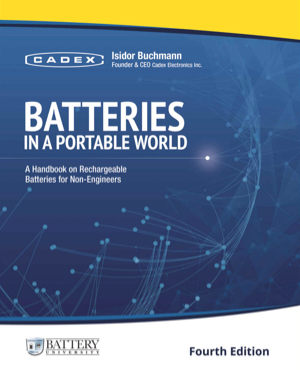
Isidor Buchmann is the founder and CEO of Cadex Electronics Inc. as well the author of Battery University.
Fascinated with electronics during his school years, Isidor built and sold broadcast radios that ran with no external power source – they only required an antenna and a ground wire (no battery needed).
During his apprenticeship, he invented an internal combustion engine that was based on continuous propulsion. Felix Wankel in Germany, the inventor of the Wankel Rotary Engine, reviewed the drawings and theory of operation and replied that while the design was unique and original, manufacturing would be too expensive for commercialization. The continuous propulsion ICE invented by Isidor was never built.
After graduation, Isidor left his native Switzerland and immigrated to Canada to pursue a career in electronics. When the anticipated job opportunities did not materialize, he pooled his savings and started his own company. In a small room at his house he worked on product developments long into the night while raising a large family.
Isidor conceived the business model in the early 1980s while working at General Electric. NiCd batteries caused many failures then, and while repairing two-way radios he discovered a way to rejuvenate these “memory” prone batteries. In his spare time at home, he developed a battery analyzer that featured the proprietary “recondition” program. To prevent conflict of interest with GE, Isidor quit his job and went on his own. The beginning was challenging but with perseverance, his company Cadex Electronics, eventually flourished.
Isidor knew early on that manufacturing battery analyzers to reverse memory had a limited market, and in 2000 Cadex began researching battery diagnostics that included rapid-test methods. The development secured several patents and established a leading position in the field of battery diagnostics and monitoring. Spectro™, one of the inventions, is currently the only commercial device that employs electrochemical impedance spectroscopy (EIS) to estimate the capacity of a battery. Most competitive test systems use the simpler internal resistance method. Batteries have improved and resistance alone no longer provides reliable health indications.
Realizing the importance of batteries for an increasing number of users from all walks of life, Isidor began to write articles that have been published in roughly 300 trade magazines worldwide. Many articles were translated into different languages and he earned a writer’s award.
The growing interest in batteries enticed Isidor to publish a book entitled, Batteries in a Portable World: A Handbook on Rechargeable Batteries for Non-Engineers. The first release dates back to 1997; a larger second larger edition arrived in 2001 and subsequent editions followed. The book became a bestseller.
Isidor wanted to share his battery knowledge with a broader audience and in 2003 he began publishing the material on the web. Today, Battery University is an open teaching resource for engineers, academia, media, as well as students and ordinary battery users.
The website is continuously being updated to reflect advancements in battery technologies and how to apply them in industries. As the battery improves, Isidor believes that the use of the battery will further grow to eventually become a partial alternative to fossil fuel in the electric powertrain, drones and wheeled mobility. This, he says, has much room for improvement.
Isidor is the father of five grown children and lives in the Vancouver suburb of Burnaby. To reduce greenhouse gases and keep fit he commutes the 10km (6 miles) trip to work by bicycle, rain or shine. The downhill ride to the shores of the Fraser River where the Cadex Headquarters is located is easy; climbing the hill in the evening takes a bit more effort. He believes in human propulsion and has not yet switched to an e-bike. He wants to keep the fossil fuel that is so frivolously being burned in the ground to lower green-house gas and enable future generations to enjoy.
Isidor and the Cadex team take pride in sharing battery knowledge and are open to suggestions. We can be reached at www.batteryuniversity.com/contact

Looking for comments from the previous website?
Comments from the previous website are not compatible with our new commenting system but we have preserved them so our users can still reference and make use the information in them.

Thank you for the battery university. The best source to get trustful information.